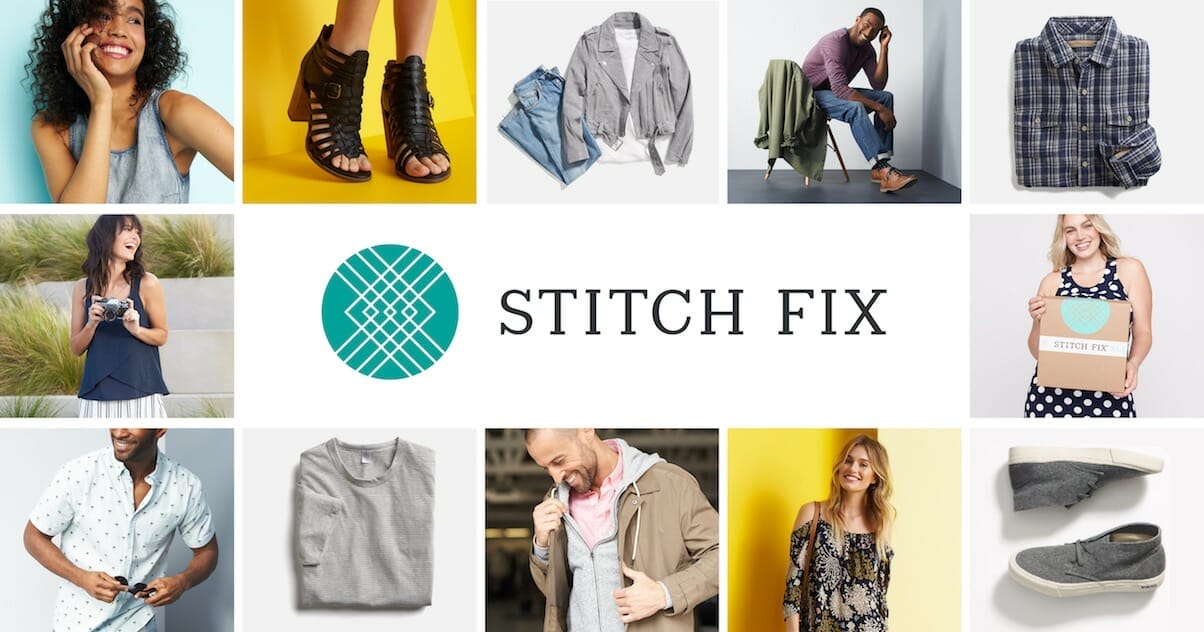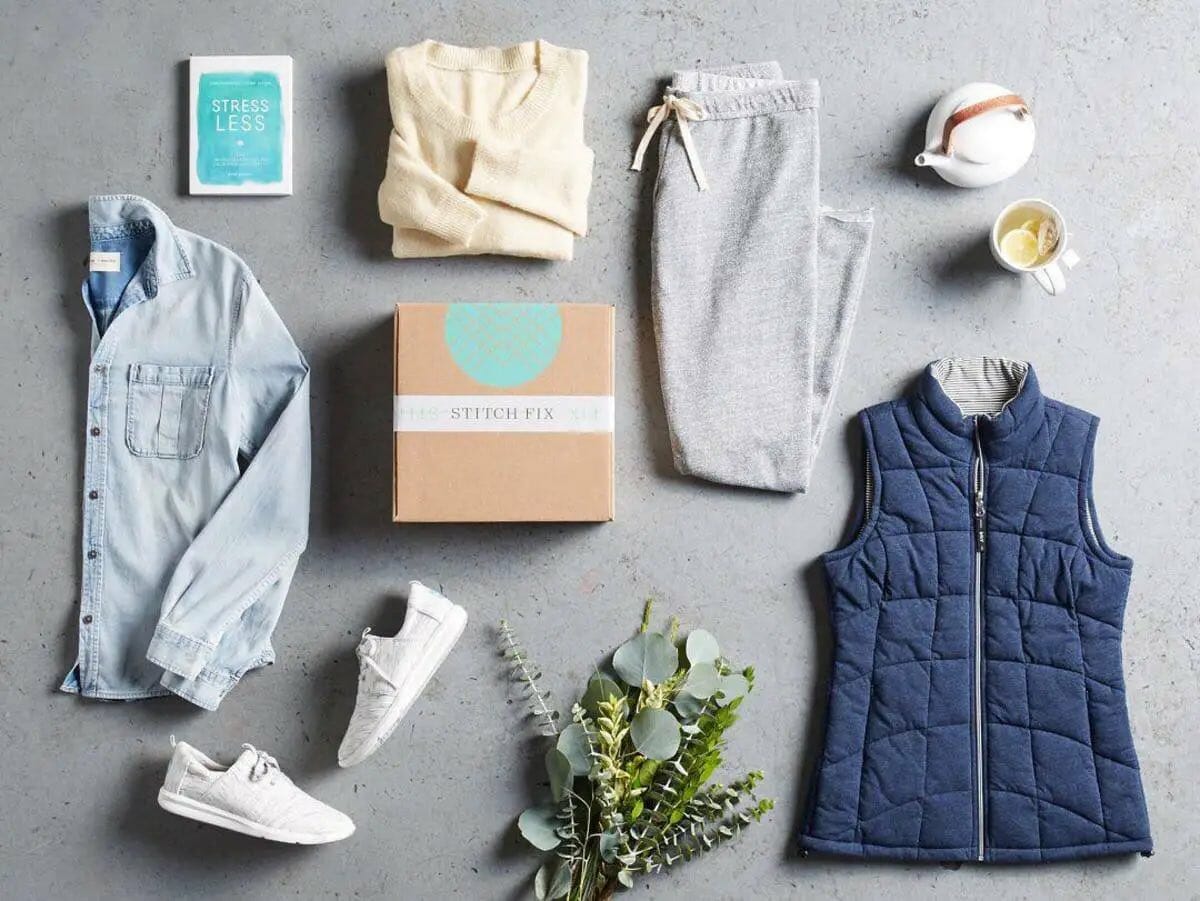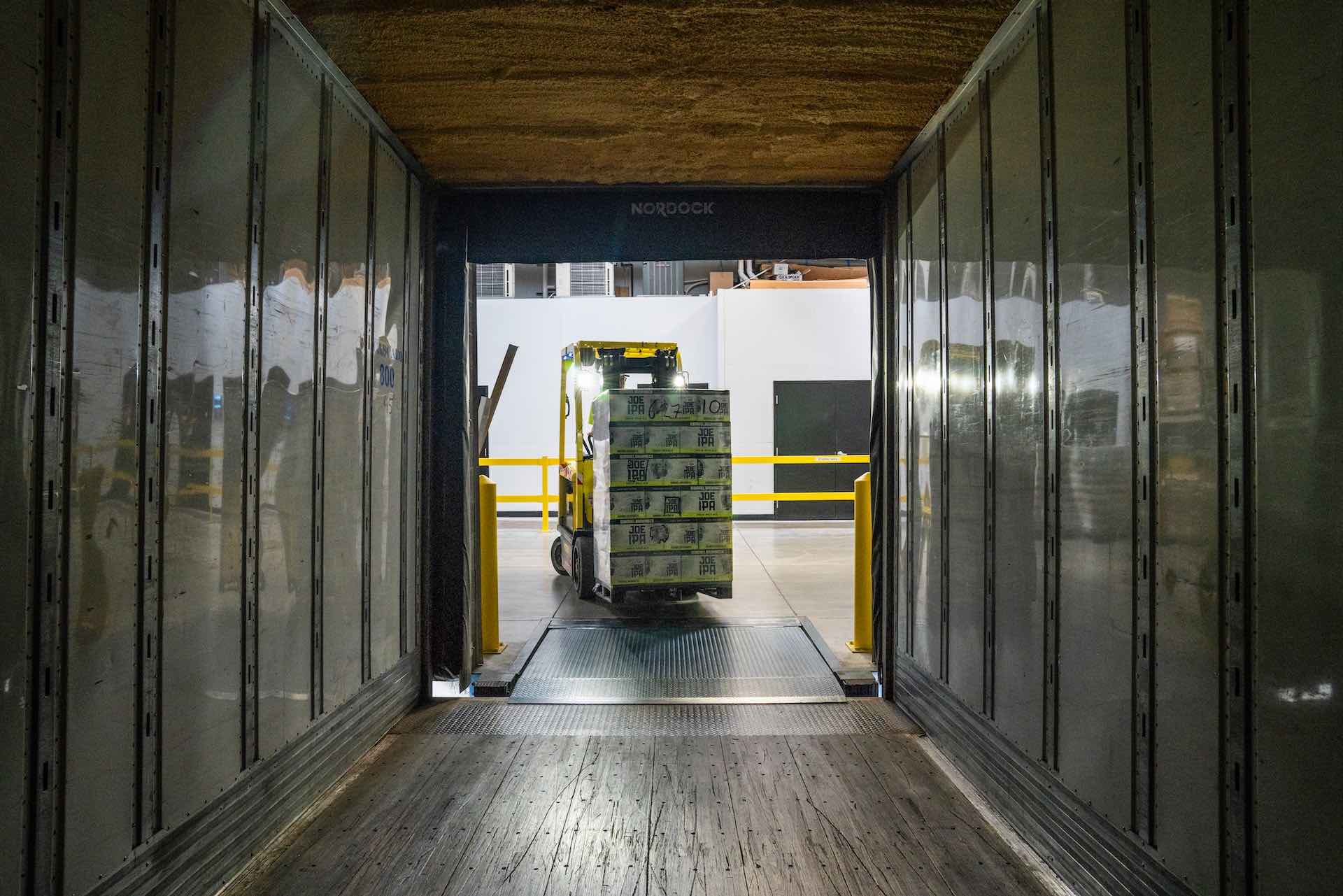You’ve likely heard of the “personal styling” service Stitch Fix, the one that sends you boxes of clothes in the mail. The San Francisco-based company had been enormously successful financially up until 2022, ultimately going public in 2017.
Stitch Fix founder, Kimberly Lake, has an inspiring story. Compare the time and cost of Stitch Fix to hiring a 1-1 personal stylist and it’s easy to see the immediate appeal. Not to mention, Stitch Fix founder, Kimberly Lake, succeeded in the very sexist silicon valley startup culture.
But despite all that Stitch Fix has going for it, there are several questions worth addressing when you look at it. It’s 2023, and sustainability has become a key concern in fashion, but is this style personalization service up to speed with the times?
Also, while Stitch Fix might seem cheaper and faster than a personal stylist, is it actually cheaper or better? And is it more or less sustainable?
Let’s dig in.

What is Stitch Fix?
Stitch Fix is a personal styling service that started as a subscription box, now it also offers the possibility of buying one-off pieces to complement the head-to-toe look, called Freestyle. Founded in 2011, its core business is based on mixing data science with art and the human touch.
To get your clothing Fix, a box of 5 items handpicked for your preferences and size by a stylist, you have to fill an initial questionnaire with basic things like your height, weight, and gender –they do not have a non-binary option– and make you choose from different style boards like the ones that you could make on Polyvore in 2010. Once you order your first Fix, the 5 items get shipped to your door and you have three days to try them from the comfort of your home. You can decide to keep or return any of the items in your box, you can even choose to return all of them for free.
However, if you keep any, you get a 25% discount on the garment’s price. Sounds good, right?
I find it cumbersome to try on clothes at stores sometimes. The unflattering lights, the loud music, the fact that you don’t have all the time you need to do so because there are other people in line or you can’t even have your friends in the dressing room at some retailers.
Stitch Fix’s idea is good on paper because it solves that issue with the added value of having someone hold your hand while you buy. Do you need a dress for your friend’s black tie wedding or not sure what to wear to hike? Your personal Stitch Fix stylist has got you. A 10/10 experience right? Except at their core, they are not considering the social and environmental impact of their business model, their private line, or choosing all of their brands with ethical criteria.

What is Stitch Fix’s Business Model?
Their main business model is the clothing subscription box. As of Q1 of 2023, they had amassed revenue of 456M and had 3.7M clients. And even though they have tried to penetrate the men’s and kids’ market, three-quarters of their business is still women.
Subscription goody boxes are usually offered to satisfy three different types of needs: replenishment, curation, or access. Stitch Fix falls into the curated products and services bracket because of how stylists personalize what you get based on a style quiz and the feedback you give your personal stylist.
According to a study, done by Mckinsey in 2018, “15 percent of online shoppers have signed up for one or more subscriptions to receive products regularly, frequently through monthly boxes”. And over half of the subscribers of the study use such services for curated products and highly personalized experiences, like the one Stitch Fix can offer.
These subscription models have grown by more than 100% since 2013, and in 2021, the US consumer had on average four subscription services. Back in 2018, when the Mckinsey study was published, 60% of the clients were women and the majority of users were between 25-44 years old.
Is Stitch Fix Eco Friendly?
Not exactly. The subscription model in itself is not that sustainable, and Stitch Fix does not vet all of its brands for sustainability. Below, you’ll find our analysis as to why we don’t believe the brand is very eco-friendly.
Are Box Services like Stitch Fix Good for the Planet?
Having a fashion subscription may be convenient but at least in its most basic iteration, it is not good for the planet. They are driven by the knowledge that the act itself of buying something new, the anticipation, releases dopamine, one of our feel-good chemicals.
Getting a purchase from your box feeds into our wired need for newness, and our yearning for consistency, and eliminates the choosing fatigue. Since the stylists pick for you and you can return anything you don’t want, there is no commitment involved. And as behavioral science has proven, not committing to something, and having so many choices, actually makes us unhappy.
All of this promotes overproduction and overconsumption. Even with a data-driven brand powered by sophisticated algorithms and knowledgeable stylists that take out the uncertainty in the way we shop, predicting what consumers will want still isn’t an exact science. In fact, during the pandemic, Stitch Fix struggled to predict consumer behavior too. This usually ends with warehouses filled with unsold inventory that, as we know, usually ends up landfilled or incinerated in the Global South.

Not to mention, the amount of waste that ends up in those landfills due to returns and exchanges, which Stitch Fix offers for free. Nowhere on their website does it say what happens to those returned goods, there is zero transparency or accountability on the subject on their part. All we could find was a post by a Redditor.
What is the Issue with Returns?
Even though we could not find the exact number of returns in the brand’s investor report, we do know from US figures that it is a deep economic and environmental issue. Insider reported that according to the National Retail Federations, US shoppers “returned $816 billion in goods” in 2022. According to an estimate made by the returns platform Oporto, the equivalent of 10,500 fully loaded Boeing 747s will end up in landfill in 2022: this amounts to 9.5 pounds of waste in total, just in the US. This happens because if it costs more to process, fix, and resell the items, retailers don’t see the financial value of doing so.

Does Stitch Fix use Sustainable Packaging Material?
Another environmental issue that these models tend to have is excess packaging. And consumers are fed up with it. In a report released by packaging business DS Smith, cited by BusinessWire, 81% of respondents said the sustainability of packaging matters to them, so much so that about 40% would pay more for that. They are tired of packages being too big for the products shipped, brands using too much filler, too much plastic, or materials that are not recyclable.
Stitch Fix has made some strides in this regard. Their boxes are made with 100% post-recycled FSC-certified material and are recyclable. They use 100% FSC-certified recycled and recyclable in-box kraft paper.
They have also reduced box sizes, sometimes up to 24%. The Freestyle product mailers are made from 100% recycled material, recyclable, and are sourced and manufactured in the United States. Additionally, they joined Canopy’s Pack4Good initiative, which ensures all of their paper and packaging supply chains are free of Ancient and Endangered forests.

Does Stitch Fix Sell Sustainable Brands?
Stitch Fix sells a lot of brands, up to 150, including their private lines, and they pick them based on having a balance of categories from casual to sleepwear to occasion wear, not for their sustainability. Their brand mix includes brands we’ve failed like Free People and Alternative Apparel, as well as some fast fashion brands.
They do offer some sustainable options based on your personal preferences like Girlfriend Collective, Toad & Co., Save the Duck, or prAna. However, overall, their brand mix is not something we would recommend or consider sustainable.
How Ethical and Sustainable is Stitch Fix?
At Eco-Stylist we rate brands’ sustainability based on these three pillars: transparency, fair labor, and sustainably made. Brands pass if they get an accumulated score of 50 points, based on the practices done in each pillar. Let’s dig into this brand’s initiatives or lack thereof.
As we said above, not every Stitch Fix brand is sustainable. They carry some sustainable brands and have launched some conscious capsule collections, but in our current climatic and social emergency doing capsule collections is just not enough.
The same goes for the donation program: they work with Goodwill to allow their customers to donate their used items but there is no info on where those end up or on a program to take back the returns, excesses, or unsold inventory. Additionally, as the OR Foundation and Aja Barber have highlighted, a donation in mass is not a sustainable strategy. It’s just a way to turn countries of the Global South like Chile or Ghana into landfills for the Global North’s overconsumption, pollutes their lands, and erodes their local design and manufacturing sectors.
The company also does not disclose CO2 emissions or enforcement of MRSL or ZDHC chemical programs.
Stitch Fix Sustainability Rating

We rate brands as failed (we don’t recommend) or passed (we recommend), with passing brands rated on a scale from Certified to Silver to Gold. To do so, we consider their transparency, ethical labor practices, and ecological sustainability, among other factors we will expand on below.
Transparency Rating
Stitch Fix is somewhat transparent, but it could do much better. They publish their factory list, and have a vendor code of conduct “to ensure that there are no subcontracting issues”. On their website, there are no aggregated audit findings, language on risks in their supply chain, number of workers, wages, a list of material suppliers, programs to engage facilities beyond cut and sew, or info on take-back programs or excess treatment.
Fair Labor Rating: Is Stitch Fix Ethical?

Stitch Fix has some private brands but also works with foreign ones. In terms of fair labor, they don’t do much about their partner brands which you also get in your box. When we look at Stitch Fix’s collection of 150+ brands, most don’t pay living wages or do enough to ensure fair labor.
In matters of fair labor for their private brands, the tier 1 factories (the cut and sew factories) they source their private label brands from are expected to meet their Responsible Sourcing criteria for social and environmental compliance. In it, they say they “evaluate workplace conditions, wages, hours worked, health & safety, non-discrimination and more during each factory audit. Our audits evaluate factory performance based on local law and internationally accepted norms, including guidance from the International Labor Organization.”
As of August 1, 2022, they were working with 125 factories in 21 countries, where they employed over 66.000 people, 62% of whom were women. Their factories pass their annual audits with a Low or Medium Risk.
However, auditing factories is not enough. We have seen examples of factories that were “audited” that were harassing their workers or having them labor under undignified conditions. Not to mention the number of factories that end up subcontracting due to brands constantly asking for lower pricing. The subcontractors are usually located in the Global South and have garment workers working in poor conditions for low wages.
There is no evidence that Stitch Fix pays clothing makers for their private-label living wages, benefits, or any initiatives that enhance the livelihoods of their workers, their families, or their community.
Sustainably Made Rating
Stitch Fix doesn’t measure its CO2 or have a plan to reduce it, nor have they invested in technologies or strategies being developed to do so. They don’t disclose their water footprint or make efforts to reduce it in their private brands or with their brand partners. Neither does it have a program to reduce or entirely phase out harmful substances from its business model. It also does not offer to take back, repair, resell, or take responsibility for the end of life of their products. They also don’t have an environmentally conscious buying policy to choose the brands they partner with.
However, they do use boxes made from 100% post-recycled FSC-certified material. They reduced box size and weight, in some cases by as much as 24%. And use 100% FSC-certified recycled and recyclable in-box kraft paper. Their mailers are made from 100% recycled and recyclable materials, sourced and manufactured in the United States. To keep doing the work in the packaging front, they joined Canopy’s Pack4Good initiative to ensure that their paper and packaging supply chains are free of Ancient and Endangered forests.
What Materials Does Stitch Fix Use?

Stitch Fix offers more than 100 brands to their customers, which they can get either in their Fix or through the Freestyle option. Nowhere on their website does it say what it is the material breakdown of the brands they work with. They do not disclose if these brands use BCI cotton or polyester, whether they have certifications or not, or if they are doing anything to address the impact of chemicals in their clothes.
In their private label, they source 59% of the main materials from “more sustainable materials”. 48% of their cotton is sourced from the Better Cotton Initiative. 28% of their polyester comes from recycled sources, certified by the Global Recycled Standard (GRS). 93% of the viscose in their private label items is sourced more sustainably than conventional alternatives through a partnership with Canopy.
They do not use animal fur, angora, or mohair in any products their boxes contain. However, they do not address the issue of chemicals like lead, PFAs, or phthalates that have been found in our clothes.
Stitch Fix says it has some brand partners that participate in initiatives or use eco-fabrics, however, it does not specify what percentage of its brands are using said fabrics or have been certified. The ones they name are ECONYL® Nylon, ECOVERO™ Viscose, Fair Trade Certified™ Cotton, Hemp/Jute, Organic Cotton, Tencel, NEST, or BSR HERproject™, among others. This is a perfect example of greenwashing: mentioning sustainable certifications to boost your credibility without saying what percentage of your clothes have those certifications, especially if it’s a minority of the overall items.
Stitch Fix makes some progress on sustainable fabrics with its private label, but overall is lacking in this category when you consider all of its brands.
DEI Rating
Within their staff and private brands, they offer 16 weeks of paid parental leave and equal benefits, regardless of gender or family composition. They also introduced health benefits for transgender employees to navigate gender transition. They established a system of equal pay for equal levels, roles, and locations.
Since its founding, they have had a heavy focus on the representation of women where they have historically been marginalized, like in technical or leadership roles. As of 2022, 44% of their tech employees were women and 71.2% were senior leaders.
Regarding the hiring of people from the global majority, though, there’s still a lot of work to do. 65% of their leadership is white, 12.2% is Asian, 5.8% black, 4.4% is Latinx, and 0.8% identifies as indigenous.
They also annually produce the Elevate Initiative which is a collection made by the next wave of black entrepreneurs. The entrepreneurs receive a grant to grow their businesses, along with eight months of support from leadership and Brandice Daniel, their partner from Harlem’s Fashion Row and podcaster.

Our Principles
The above categories are ones where the brand can earn positive points. However, there are other relevant factors to consider when vetting brands as ethical and sustainable: Is the brand fast fashion? Does the brand inspire us? Do we trust the brand?
These are questions that if our team answers no, will mean negative points for the brand. If it answers yes, then the score is zero and the overall band score is not affected. This helps to ensure we only recommend the best brands to you, brands that are better for people and the planet.
Let’s see how Stitch Fix stacks up.
Is Stitch Fix Fast Fashion?
Not exactly but they do sell it. One of their brands, Junarose, for example, is a fast fashion brand, sold in marketplaces like ASOS, Poshmark, and Amazon. They also sell fast fashion brands Free People and Blank NYC.
Like fast fashion, they also encourage continuous consumption they thrive on it. If you want to know more about why fast fashion is bad for you, garment workers, and the environment, check out our deep dive.
It’s a bit complicated with Stitch Fix but since most of what they sell isn’t fast fashion, we didn’t subtract any points here.
Does the Brand Inspire Us?
Stitch Fix is doing some work, but they are not leaders in ethics or sustainability that inspire us as an industry to do better. They do not vet all of their brands on sustainability and they only do certain sustainable or inclusive collections.
And we are not gonna fix the pressing climate and equity issues we face one collection at a time. Change has to be systemic, as Celine Semaan, from The Slow Factory, has said. Stitch Fix does not have a systemic view of impact. Hence why it gets -10 points in this category.
Do We Trust the Brand?
Trust is built with actions, not words. And we have seen the pretty incredible gymnastics some brands have done with their communication to deceive customers into thinking they are sustainable, instead of putting their money where their mouth is and investing those marketing dollars into real initiatives for change. This is what we look out for when we ask ourselves if we trust a brand: are they greenwashing? Are they using social enterprises as a way to up their social status without any real commitment or continuity?
Stitch Fix, unfortunately, failed in this category too. Stitch Fix says it has brand partners that participate in initiatives or use eco-fabrics, however, it does not specify what percentage of its brands are using said fabrics or have been certified. This is misleading because it could be one brand, or only one collection or item in one brand made from ECONYL, for example. Showing off certifications like Fair Trade without giving context into how much of your clothes are made that way, is classic greenwashing and misleads consumers.
So they get -10 points in this category too.
Is Stitch Fix Sustainable? Overall Score: 8 points
- Transparency: 5
- Fair Labor: 4
- Sustainably Made: 15
- DEI: 4
- Is the brand fast fashion?: 0
- Does the brand inspire us?: -10
- Do we trust the brand?: -10
How Important is Sustainability for Brands?
Sustainability is becoming increasingly important for modern brands. As consumers become more aware of the environmental and social impact of their purchases, they expect companies to put responsibility at the forefront. Brands that act responsibly have the opportunity to stand out from the competition, build trust with customers, and create a more equitable world.
Sustainability is no longer a nice-to-have for brands but rather a necessity. Companies must be held accountable for their impacts and should strive to incorporate their values into every aspect of their business to assure their consumers that they are doing good whilst looking good in what they craft.

Where Can You Find More Sustainable Alternatives to Stitch Fix?
Start with our sustainable personal styling service. We source 100% sustainable brands, 0 fast fashion, and research brands with consistent criteria.
Box services might be convenient, but supporting sustainable brands is a whole lot better for you, garment workers, and the planet.
Since we know it can be confusing to split the greenwashers from the companies that make an impact, we made a directory of the best ethical and sustainable brands. You can browse and filter by categories such as the type of product, the sizes, location, values, and our rating. We rate brands on a scale from Certified to Silver to Gold and consider their transparency, ethical labor practices, and ecological sustainability when we rate them.
What Can Ethical Fashion Brands Learn from Stitch Fix?
Even though Stitch Fix is not a sustainable brand, we think that they are doing some things that would make sustainable brands more competitive and deliver a better customer experience. Stitch Fix’s genius was in pairing data with art and the human touch. In really getting to know their customers not only through the algorithm but also through their stylist’s feedback and offering something that caters to their actual audience needs: a personalized experience.
A brand does not need to become a box service or have stylists do just that. Sustainable brands would do good to really listen and design accordingly, without losing the principles.
*Cover image credit: Daniel G. Wells III (https://commons.wikimedia.org/wiki/File:Everyone’s_favorite_Box_Image.jpg), “Everyone’s favorite Box Image”, https://creativecommons.org/licenses/by-sa/4.0/ legalcode

Adela is a Colombian storyteller, content maker, strategy consultant, & event producer, specializing in sustainable fashion, mental health, and gender issues.









